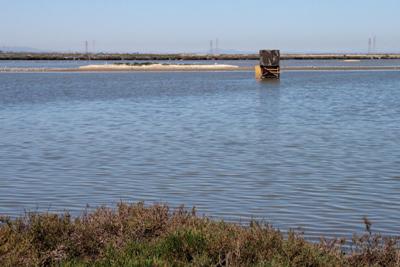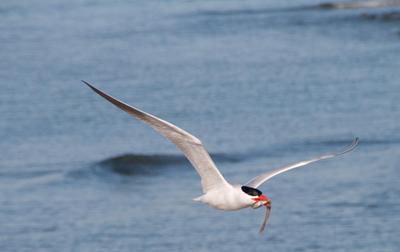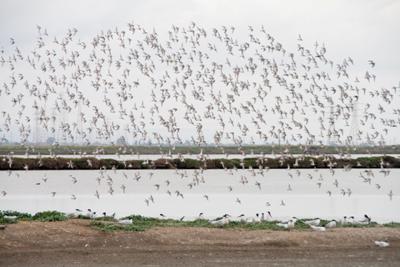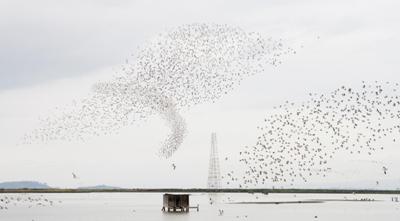 Fish watch at Stevens Creek
Fish watch at Stevens Creek
Editor’s Note: There are only 4 Caspian tern breeding colonies in the Bay area, and construction of additional nesting islands for Caspian terns is being contemplated. But before the islands are built and terns are attracted to nest there, we are looking at the diet of terns nesting at existing colonies to see if endangered or threatened species of fish might be negatively affected by Caspian terns nesting in the area. Jonathan Felis, a biological field technician with the San Francisco Bay field crew, describes what it’s like to collect diet data from terns nesting at one of these colonies, “B-2”.
Compared to our other sites, Steven’s Creek (B-2) gets a bad rap. From our back door, a twenty-minute kayak paddle takes us to Brooks Island, the location of the largest Caspian Tern nesting colony in the San Francisco Bay and our main field site. Ideal, if you ask me. Eden Landing, a bit further away, requires a forty-minute drive. But as soon as we hop out of the truck and into the blind, we’re watching terns furiously deliver fish.
B-2 is a different story. Situated near Silicon Valley in the southern extremities of the San Francisco Bay, B-2 is an old, diked salt pond long-ago cut off from the ebb and flow of Bay tides and now managed as part of the Don Edwards National Wildlife Refuge. Significantly further from home than Brooks Island or Eden Landing, it takes an hour and a half to drive here when traffic is mellow. However, more often then not we end up bumper to bumper in a hot truck sweating buckets.
Once off the highway, we open and close a few gates, navigate the truck along a series of dikes, and finally park alongside the salt pond that is home to the tern colony. The pond is a few square kilometers in extent and is peppered with a dozen or so small, scrappy islands. I throw a kayak in the water and start to paddle out to the blind, set up on stilts about fifty meters from the island where the terns nest.
 |
What makes this fun is that the water is only about a foot deep at best, below which lies slimy, oozing mud. When the boat gets stuck, I climb out to get it over the shallow spot and sink in deep. Now, I’m a tall guy with some of the longest legs around, and I sink in to my knees (I’ve seen our shorter crew lead get down almost to her waist on one occasion – good thing she has chest-waders).
After twenty minutes of pulling myself the hundred meters to the blind, I climb in and set up while my muddy feet begin to dry (probably a good skin exfoliant and, combined with the truck sauna, the completion of the B-2 spa experience). I open the windows and look to the twenty-meter scrap of bleached-out mud where the Caspian Terns have chosen to nest, and I begin to wait.
….Still waiting, and no fish. To date, B-2 is notorious for being the slowest site to observe, with the fewest fish deliveries by far. Most effort, least action. Which is why we so often grumble about it.
But here’s a tern with a fish, finally! A goby. Only about eleven centimeters long, it isn’t particularly impressive to me or the other terns, but I’ll take what I can get.
 |
Trying to drum up support for its meager offering, the tern lands, picks up and lands at various spots throughout the colony, but ultimately none of the other terns seem to care. So, it takes flight and heads off into the distance with no followers. Tracking it across the water with my binoculars, Google’s office-headquarters passes through my field of view in the background. Thinking of the folks writing HTML code and fighting fax machines inside behind the mirrored glass makes dragging my boat through some mud to watch terns laze around from my cubicle on the water seem okay.
Actually, on a day like today, it’s more than okay. Today, whoever’s hand is holding the drain plug in B-2 has dropped the water level down low – enough to fabricate a low “tide” – exposing mudflats around the nesting island. These shallows dwarf B-2 four times in area and make way for a grand showing of migrating shorebirds. A few hundred marbled godwits just flew around – no, flew through – the blind. They circle round to land on a mudflat and immerse themselves in the commotion of at least a thousand western sandpipers, dunlin and dowitchers that are already frantically foraging on the ground. Tails up, faces in the mud, the masses are working over the mudflat and shallow waters, surrounding the Caspian terns on their small island. And the same is happening (minus the terns) on a half dozen other patches of wet mud throughout the pond.
 |
In an instant, all the shorebirds take flight as a northern harrier enters the scene. Owl-faced and silvery-gray, he cuts through the flocks and gets nothing. The terns are unfazed and play it cool; but as far as I can see, great winged constellations swarm as bodies and limbs across the sky, expanding and contracting, splitting and merging, reaching and breathing, and B-2 is my favorite site.
 |
Because B-2 is so far from home and installing a water-blind seemed daunting we almost didn’t monitor this site. But with some help from the folks at Don Edwards NWR we had a blind up in no time at all and I’m happy for it. The terns seem to be taking it slow now, but as they initiate more nests I’m sure the action will pick up. For now, the shorebird show keeps me entertained.
- Jonathan Felis, Fish and Wildlife Technician, San Francisco Bay



